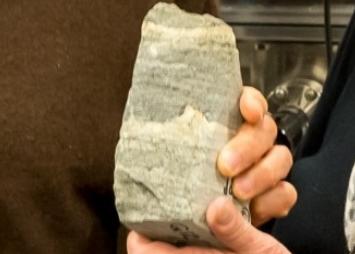Australian researchers discover oldest evidence of life on Earth

A 3.7 billion year old rock from Greenland containing a stromatolite University of Wollongong
Australian researchers have found the world’s oldest fossils in a remote area of Greenland, demonstrating that life emerged rapidly during the planet’s early history.
The team, which includes UNSW Professor Martin Van Kranendonk, discovered the 3.7 billion-year-old fossil stromatolites – formations created by communities of ancient microbes – in the world’s oldest rocks in the Isua Greenstone Belt along the edge of Greenland’s Ice Cap.
The stromatolites, which were exposed by the recent melting of a perennial snow patch, are 220 million years older than stromatolites from the Pilbara region of Western Australia which were previously regarded as the world’s oldest.
The research team, led by Professor Allen Nutman of the University of Wollongong, says the discovery not only provides greater insight into the early diversity of life on Earth; it could also have implications for our understanding of life on Mars.
The findings are published today in the journal Nature.
“This discovery represents a new benchmark for the oldest preserved evidence of life on Earth,” says Professor Van Kranendonk, Director of the Australian Centre for Astrobiology in the UNSW School of Biological, Earth and Environmental Sciences.
“The structures and geochemistry from the newly exposed outcrops in Greenland display all of the features used in younger rocks to argue for a biological origin.
“It points to a rapid emergence of life on Earth and supports the search for life in similarly ancient rocks on Mars, which was a damp environment 3.7 billion years ago,” he says.
For much of Earth’s history, life was just single cells. Stromatolite fossils are layered mounds of carbonate constructed by these communities of microbes as they grow.
The 1 to 4-centimetre high Isua stromatolites were laid down in a shallow sea, providing the first evidence of an environment in which early life thrived. Their discovery pushes back the fossil record to near the start of the Earth’s geological record.
“The significance of stromatolites is that not only do they provide obvious evidence of ancient life that is visible with the naked eye, but that they are complex ecosystems,” says Professor Nutman, who is also an Associate Member of the Australian Centre for Astrobiology at UNSW.
“This indicates that as long as 3.7 billion years ago microbial life was already diverse. This diversity shows that life emerged within the first few hundred millions years of Earth’s existence, which is in keeping with biologists’ calculations showing the great antiquity of life’s genetic code,” he says.
Co-lead investigator Associate Professor Vickie Bennett from the Australian National University says the study provides a new perspective on the history of the Earth.
“This discovery turns the study of planetary habitability on its head,” she says. “Rather than speculating about potential early environments, for the first time we have rocks that we know record the conditions and environments that sustained early life. Our research will provide new insights into chemical cycles and rock-water-microbe interactions on a young planet.”
Professor Martin Van Kranendonk adds: “UNSW research into early life on Earth continues through the Australian Centre for Astrobiology, which integrates knowledge from early Earth with modern microbial systems to better understand where to explore for life on Mars, in the rest of the Solar System, and beyond.”
Several lines of evidence, such as details of the chemistry, sedimentary structures and minerals in the rocks, together indicate that the stromatolites were formed by live organisms. Previous genetic molecular clock studies suggest life originated on Earth more than 4 billion years ago.
The investigation, conducted by the Australian science team in collaboration with a UK partner, was funded by a grant from the Australian Research Council. The team also includes Professor Allan Chivas from the University of Wollongong.
Further information
Institut Ranke-Heinemann / Australisch-Neuseeländischer Hochschulverbund
Pressestelle Friedrichstr. 95
10117 Berlin
Email: berlin@ranke-heinemann.de
Tel.: 030-20 96 29 593
or
Professor Martin Van Kranendonk
UNSW Science
m.vankranendonk@unsw.edu.au
Professor Allen Nutman
University of Wollongong
anutman@uow.edu.au
http://www.ranke-heinemann.de
http://www.ranke-heinemann.at
http://www.ranke-heinemann.tv
Media Contact
All latest news from the category: Earth Sciences
Earth Sciences (also referred to as Geosciences), which deals with basic issues surrounding our planet, plays a vital role in the area of energy and raw materials supply.
Earth Sciences comprises subjects such as geology, geography, geological informatics, paleontology, mineralogy, petrography, crystallography, geophysics, geodesy, glaciology, cartography, photogrammetry, meteorology and seismology, early-warning systems, earthquake research and polar research.
Newest articles

First-of-its-kind study uses remote sensing to monitor plastic debris in rivers and lakes
Remote sensing creates a cost-effective solution to monitoring plastic pollution. A first-of-its-kind study from researchers at the University of Minnesota Twin Cities shows how remote sensing can help monitor and…

Laser-based artificial neuron mimics nerve cell functions at lightning speed
With a processing speed a billion times faster than nature, chip-based laser neuron could help advance AI tasks such as pattern recognition and sequence prediction. Researchers have developed a laser-based…

Optimising the processing of plastic waste
Just one look in the yellow bin reveals a colourful jumble of different types of plastic. However, the purer and more uniform plastic waste is, the easier it is to…



